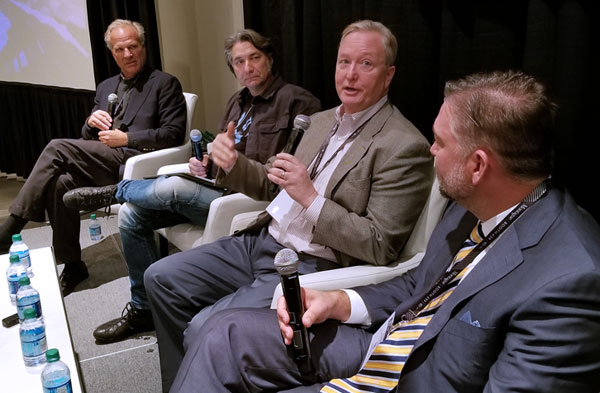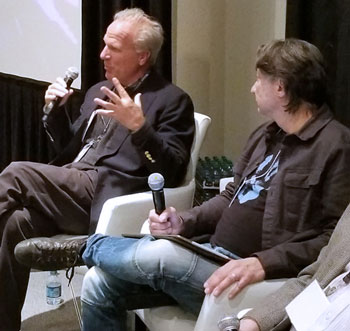✕

Column: industry Tag: hotel company,hotel investments,design Published: 2017-12-15 14:53 Source: Author:

From right: Dan Hansen of Summit Hotel Properties, David McCaslin of Hersha Hospitality Management, Gene Kornota of Rebel Hospitality and Thomas Prins of TQP Capital Partners participate in the BDNY “Investors outlook” panel. (Photo: Jeff Higley)
NEW YORK—Working with designers has become more fun for investors and developers over the years as the phases of projects have become more intertwined. But it’s not always easy to be on the same page, according to hotel owners speaking on the “Investor outlook” panel at last month’s BDNY event.
Gene Kornota, principal with Chicago-based Rebel Hospitality, said the most fun part of developing a hotel is getting everyone—including designers—involved in the project from the very beginning.
“You never know where all the ideas are going to come from,” he said. “Everybody feels like they’re participating in creating this new brand, and it’s about the messaging.”
Kornota gave as an example the Acme Hotel project in Chicago, where the notion of celebrating self-expression was entwined in the concept from the early stages.
“We always go back to that core value,” Kornota said. “The Acme’s a great example where a designer came up with the idea about coffee. We all debate about coffee, right? Do you have an in-room coffeemaker, or do you not? It may not seem like a design element, but … we always think about the guests first—what is that we want when we’re in a room and what message do we want to send to guests? How do you get a great cup of coffee to the guests without making them pay an arm and a leg?”
The solution at the Acme was to deliver a hot Thermos of coffee in the morning at the time a guest specifies by requesting it through the Amazon Echo in the room.
“We deliver the coffee hot, at the door, just a light knock, and leave,” Kornota said. “People are so overwhelmed by it. They get this amazing, great coffee, and it stays hot—so even if they’re still sleeping, they’ve got it. That idea came from our designer in pooling these ideas.”
Communicating with designers helps to cultivate their ideas, speakers said.
Dan Hansen, chairman, president, and CEO of Austin, Texas-based Summit Hotel Properties, said his company has changed the way it works with designers to ensure longevity and relevance in its projects—especially when it’s a renovation that needs to last seven to 10 years.
“To make it feel new and distinct and unique, you almost have to touch everything,” he said. “Our conversation with the designer is, ‘Cool is great, but trendy just scares me.’ I want it to be cool and timeless, where if there’s a new trend or a new color scheme that comes out, that you can change it with pillows and artwork, and you’re not tearing up floors and carpet.”

Thomas Prins of TQP Capital Partners talks about the current investment climate in the hotel industry as Gene Kornota of Rebel Hospitality listens during the BDNY “Investors outlook” panel. (Photo: Jeff Higley)
Hansen recalled a design package from Courtyard by Marriott in the early 2000s that included a lot of pink.
“Because of the (ensuing) downturn … nobody had the money to renovate it,” Hansen said. “It was around for like 12 years, and every time you walked to this hotel it was like, ‘Oh gosh.’ Even if it was … clean, it just felt old. So I panic about colors now, and I want that to be something that you can keep fresh and exciting. I don’t know if that’s too much or not enough, but we really think about it in 10-year timelines.”
Kornota said he sympathizes with designers.
“In all fairness to designers, we want the look, we want to buy it right, we don’t want to pay a fortune, and we want it to last. It’s not an easy job,” he said.
David McCaslin, EVP at Philadelphia-based Hersha Hospitality Management, said attitude toward design partially depends on the type of owner you are. For example, private equity likes a five-year hold period, and conversations with designers focus on maximizing the value of the flip. That sometimes includes not renovating certain areas so the next buyer has some value-add opportunities.
“Those were not generally easier conversations with designers who generally wanted to touch everything all at once,” McCaslin said. “If you’re a long-term holder, that is exactly the right thing to do. If you’re not a long-term holder, it does take somebody on the other side that understands why you’re doing X versus Y because it’s purely an economic drill at that point.”
Few worries about current climate
The speakers said they’re not too worried about the current economic environment squelching deals and renovations at this point, although there are some concerns.
“Things don’t feel terrible,” Hansen said. “That seems a little bit like an oxymoron—not feeling terrible is the new ‘good.’ … Rate has been stubborn, the business traveler has been skittish and somewhat absent, but we think there’s a pending demand for business travel, and are actually more optimistic than most for next year.”
McCaslin described himself as a “cautious bull,” but said that “there isn’t anything bad” on the horizon necessarily. “The fact there isn’t this massive 8%, 9%, 10% (revenue-per-available-room) growth is actually a positive because it has prevented overbuilding. Once you actually see the supply numbers overtaking demand numbers, we’ll start to move back, but so far it hasn’t actually happened.”
Thomas Prins, principal of TQP Capital Partners added: “I just came from The Lodging Conference?in Phoenix, and what I got out of that was that there’s a lot of overbuilding going on.”
McCaslin said investors believe they’re not going to get much help from the market so whatever value they cultivate will be from renovations or management efficiency.
“If it’s relatively easy to get kind of a safe deal with a good cash and cash return without overleveraging it, people have tended to pull back from deals that they think are more of a home run nature,” he said. “There’s not a lot of developers who are developing who are planning on holding for 10 years.”
That long-term commitment requires a different frame of mind, according to Hansen. Summit?went public in 2011 as the current cycle was getting off the ground. Since then, the company sold 53 of the 65 hotels it held when it went public, but added 67 other hotels to bring the number of hotels in its portfolio to 79.
“We saw a change in a shift, not just in demographics but what we thought were guest preference, and felt like … to build a better portfolio of companies, we needed to find better locations with higher barriers to entry,” Hansen said. “We are big fans of the brands, as far as it relates to loyalty. Our shift has been to bigger hotels and markets with broader and more diverse demand generators.”
Concerns that affect outlook
Each panelist was asked, “What keeps you up at night?” Their responses included concerns about hotel supply, taxes and other factors.
Thomas Prins, TQP Capital Partners: “Supply. In a lot of cities that we’re in, every time I turn around there is something proposed or something going up. We’re in Miami, we’re in LA, and when you look at this skyline and you see all the cranes, a lot of them are hotels going up.”
Gene Kornota, Rebel Hospitality: “We live in a state that has a severe budget shortfall, severe pension shortfalls, and those solutions generally translate to higher taxes, higher real estate taxes. We saw our taxes go from $1,500 a key to $4,500 a key over a period of years. That wipes out all the work that we’ve done. … It wipes out $10 million in value on a 250-room hotel, for example, when capped at 6% or 7%.”
David McCaslin, Hersha Hospitality Management: “I would say that if I look at the supply piece, the money is a little bit sheep-like. It likes to go to urban, high-barrier-to-entry markets, which is why you see concentrations of supply going in those markets because everybody is doing the same thing. My fear is it’s like a slow death … you’re going to have a stable market, your RevPAR will actually go up, but it’s going to go up by 2% to 3%, somewhere in that neighborhood, which isn’t horrible. But I think you’re going to see labor costs rise inexorably; you’re going to see real estate taxes rise. I predict commercial real estate taxes will grow substantially higher, and you can graph pinching deficit cities and what their deficit is relative to that. You can probably graph out a line over the next 10 years of how high real estate is going to go in those areas.”
Dan Hansen, Summit Hotel Properties: “There are a lot of controllable and uncontrollable risks. The one that I spend the most of my time worrying about is obsolescence. When we went public, we had 65 hotels. We felt like, at some point, they were not going to be as relevant as they were to us at the time. And you don’t accumulate 65 hotels quickly. It takes years—decades—and making smart decisions, buying some and selling some. But if you’re not constantly thinking about where guest preference is shifting and what are going to be the desired brands and locations and product offerings and how you deliver the authenticity and the different services, you might find yourself with a portfolio of hotels that are much less valuable than you thought. You can’t just go sell your hotel the next day; you have to market it. If you missed some sort of discernable trend of value, you might be selling it into a bad market or bad timing. So for me it’s making sure our portfolio represents the shifting guest preference and we can deliver on that.”
Previous:STR: US hotel results for week ending 9 December
Next:Hoteliers stress flexibility, culture amid labor pinch
Hot key words
Hot Products
Popular Vendors